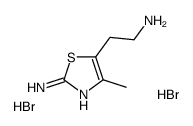Amthamine dihydrobromide

Amthamine dihydrobromide structure
|
Common Name | Amthamine dihydrobromide | ||
|---|---|---|---|---|
| CAS Number | 142457-00-9 | Molecular Weight | 319.06 | |
| Density | N/A | Boiling Point | N/A | |
| Molecular Formula | C6H13Br2N3S | Melting Point | N/A | |
| MSDS | USA | Flash Point | N/A | |
|
Modulation of in vivo immunoglobulin production by endogenous histamine and H1R and H2R agonists and antagonists.
Pharmacol. Rep. 62(5) , 917-25, (2010) The present study was designed to delineate the immunomodulatory role of histamine receptors (H1R and H2R) and their antibody generation in a rabbit model. Six groups containing 18 rabbits each received either vehicle (sterile distilled water, 1 ml/kg x b.i.d... |
|
|
Analysis of the histamine H2-receptor in human monocytes.
Biochem. Pharmacol. 92(2) , 369-79, (2014) Histamine receptors are G-protein-coupled receptors (GPCRs). Canonically, the histamine H2-receptor (H2R) couples to Gs-proteins and activates adenylyl cyclases (ACs) with subsequent adenosine-3',5'-cyclic monophosphate (cAMP) generation. Recently, the classi... |
|
|
Disruption of histamine H2 receptor slows heart failure progression through reducing myocardial apoptosis and fibrosis.
Clin. Sci. 127(7) , 435-48, (2014) Histamine H2 receptor (H2R) blockade has been reported to be beneficial for patients with chronic heart failure (CHF), but the mechanisms involved are not entirely clear. In the present study, we assessed the influences of H2R disruption on left ventricular (... |
|
|
Galphas-coupled receptor signaling actively down-regulates alpha4beta1-integrin affinity: a possible mechanism for cell de-adhesion.
BMC Immunol. 9 , 26, (2008) Activation of integrins in response to inside-out signaling serves as a basis for leukocyte arrest on endothelium, and migration of immune cells. Integrin-dependent adhesion is controlled by the conformational state of the molecule (i.e. change in the affinit... |
|
|
Histamine receptor 2-mediated growth-differentiation factor-15 expression is involved in histamine-induced melanogenesis.
Int. J. Biochem. Cell Biol. 44(12) , 2124-8, (2012) Vitiligo is a progressive depigmenting disorder. Histamine has been shown to induce melanogenesis via histamine receptor 2, suggesting the possibility of histamine as a repigmenting agent for the treatment of vitiligo. However, the role and signaling mechanis... |
|
|
Role of histamine and its receptor subtypes in stimulation of conjunctival goblet cell secretion.
Invest. Ophthalmol. Vis. Sci. 53(6) , 2993-3003, (2012) The purpose of this study was to determine the effect of histamine and its receptors on goblet cell secretion.Cultured rat and human goblet cells were grown in RPMI 1640. Goblet cell secretion of high molecular weight glycoconjugate was measured by an enzyme-... |
|
|
Involvement of histamine receptors in SAPK/JNK phosphorylation
Int. Immunopharmacol. 13(2) , 190-6, (2012) Histamine is a mediator of inflammation in allergic disease and asthma. Stress activated protein kinases/c-jun N-terminal kinases (SAPK/JNK) are involved in asthma. This study examined the role of histamine receptors on the phosphorylation of SAPK/JNK in sple... |
|
|
Positive inotropic activity of the novel histamine H2-receptor agonist, amthamine, on the human heart in vitro.
Gen. Pharmacol. 25(8) , 1649-54, (1994) 1. We tested the novel thiazole derivative, amthamine, for its ability to stimulate histamine H2-receptors in the human myocardium. 2. Experiments were carried out on isolated, electrically-driven pectinate muscle segments, excised from atrial appendages of p... |
|
|
Histamine increases sickle erythrocyte adherence to endothelium.
Br. J. Haematol. 132(4) , 512-22, (2006) Complications of sickle cell anaemia include vascular occlusion triggered by the adherence of sickle erythrocytes to endothelium in the postcapillary venules. Adherence can be promoted by inflammatory mediators that induce endothelial cell adhesion molecule e... |
|
|
Does histamine stimulate cyclic AMP formation in the avian pineal gland via a novel (non-H1, non-H2, non-H3) histamine receptor subtype.
Neurochem. Int. 27(6) , 519-26, (1995) The effects of histamine (HA) and selective HA H1-, H2 and H3-receptor agonists on cyclic AMP formation were investigated in intact chick and duck pineal glands HA potently stimulated the pineal cycle AMP formation. The effect of HA was mimicked fully by N al... |